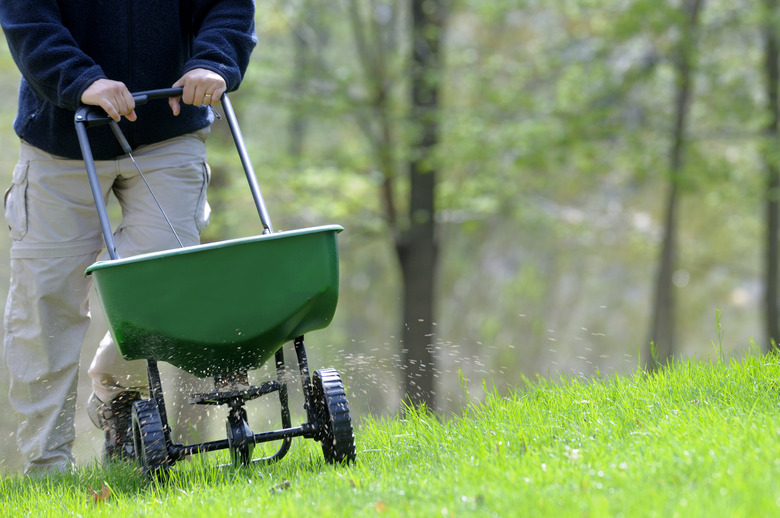When Can I Fertilize My Lawn After Planting Grass Seed?
We may receive a commission on purchases made from links.
You've seeded with a new turfgrass like Bermudagrass (Cynodon spp.) and it's growing well, looking green and healthy, and you'd like to keep it that way. Although a starter fertilizer for grass seed supports new growth, eventually your lawn will need more than that. Timing is important when it comes to that next feeding, because the last thing you want to do is burn your young turfgrass by fertilizing too soon.
Tip
If you used a starter fertilizer for grass when you planted the seed, wait another month or two before applying additional fertilizer.
Prepping the Area for Seeding
Prepping the Area for Seeding
If you want your grass to grow thick and fast, preparing a good seedbed is important. Whether you're seeding a new lawn or repairing a bare area in an existing one, putting in the time and work to create a well-prepared seedbed can mean the difference between thick new growth or sparse, spotty turf.
In both cases, remove any rocks, roots, vegetative debris, or other items that will leave the ground uneven and create a safety hazard when mowing. You also want to remove any weeds or other unwanted vegetation from the area.
To identify what amendments are needed and the type of starter fertilizer for grass you should use, getting a soil test is advised. This will tell you what nutrients your soil needs to get your grass seed off to a good start. Your local county extension office should be able to assist.
Using Starter Fertilizers for Grass
Using Starter Fertilizers for Grass
Once you've prepped your seedbed and received the results of your soil test, you can purchase any amendments like compost or well-rotted manure and appropriate starter fertilizer. For example, if your soil test results show your soil lacks phosphorus and nitrogen, you need a high-phosphorus and nitrogen lawn fertilizer. Use something like a 16-20-0 blend applied at a rate of 6 pounds per 1,000 feet. A starter fertilizer helps develop a stronger root system.
After you broadcast the starter fertilizer evenly over the prepared seedbed, you can either work it into the soil by hand or use a rototiller. Incorporate any amendments into the area at the same time. Spread the starter fertilizer and amendments evenly over the seedbed; then work them into the soil to a depth of 4 to 6 inches.
For the best results and even coverage, work the soil only when it's dry and not wet. If you can form a dirtball that remains together, the soil is too wet, as you want the soil to crumble in your hands. After applying the starter fertilizer and amendments, smooth the seedbed using a rake and then water.
Applying the Next Round of Fertilizer
Applying the Next Round of Fertilizer
While your new grass seed is germinating, be sure to keep the area moist but not soggy with regular, light applications of water. Depending on your local weather conditions, you may have to water several times each day. Continue regular water applications to keep the seedlings moist for the first three to four weeks after planting. Since the newly developing seedlings are easily injured, you should keep foot traffic off the area for the first month.
Wait a month or two before applying the next round of fertilizer. Applying too soon can burn the young developing grass. Select a high-nitrogen lawn fertilizer, such as an 30-0-4 or 16-4-8 and apply no more than 1 pound of nitrogen for every 1,000 feet of the seedbed. Water the area the day before applying the fertilizer. Spread the fertilizer evenly over the area and water in well after applying to remove any product from the grass blades that can cause burning.
References
- Clemson University: Fertilizing Lawns
- University of Maryland Extension: Care and Maintenance of a Lawn after Seeding
- University of Floida IFAS Extension: Planting Your Florida Lawn
- University of California Statewide Integrated Pest Management Program: Turfgrass Species
- University of California Statewide Integrated Pest Management Program: Starter Fertilizer
